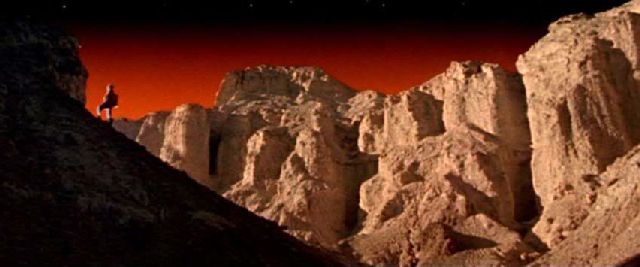Robinson Crusoe on Mars (1964) 
“A Lone U.S. Astronaut Space-Ship Wrecked on Mars!”

Director: Byron Haskin
Cast: Paul Mantee, Victor Lundin, Adam West
Synopsis: Stranded on Mars with only a monkey as a companion, an astronaut must figure out how to find oxygen, water, and food on the lifeless planet.
Daniel Defoe’s story of Robinson Crusoe lends itself to all kinds of re-interpretations when you think about it, most of which would arguably be more interesting than this lacklustre affair. The spaceships featured in the second half of the movie were knocked off from George Pal’s The War of the Worlds, and the spacesuits were from Destination Moon, and the whole enterprise has this hand-me-down feel to it. The fact that it bombed at the box office thankfully put paid to a planned sequel which was to be called Robinson Crusoe in the Invisible Galaxy.
Journeyman character actor Paul Mantee bags a rare leading role — I hope it didn’t get his hopes up about the course of the rest of his career — as Commander Christopher ‘Kit’ Draper who, with Colonel Dan McReady (Batman’s Adam West who, for some reason I remembered as the star) and their pet monkey Mona (who appears on the credits as ‘The Woolly Monkey’) are orbiting Mars on a recon mission when they find themselves on collision course with a massive meteorite. When they’re force to burn up all their fuel in order to manoeuvre out of the meteorite’s way thus setting their craft on a deteriorating orbit around the planet, they’re forced to eject from the craft in escape pods. Draper and Mona survive the descent, but Draper later discovers McReady’s body, leaving him alone on the inhospitable planet.
Given that when Robinson Crusoe on Mars was released, the first images from the planet were still twelve years away, the movie does a pretty good job of imagining the look of the place. Ok, we now know that it’s nothing like the real Mars in terms of temperature and oxygen levels — Draper finds he can breathe the Martian air for maybe fifteen minutes at a time as long as he doesn’t exert himself — and the movie’s Mars doesn’t have a lot of red about it, but the desolate rocky landscape — some of which is actually Death Valley — is pretty good. Draper finds a cave in which he sets up home, and one of his first tasks is to rig a makeshift alarm clock to prevent himself from suffocating in his sleep. Clearly, he’s not going to last too long if he can’t find a supply of oxygen pretty damn quick, and as luck — and screenwriter’s artifice would have it — he discovers that the abundance of flammable rocks scattered around the planet actually give off oxygen when burnt.
Even better than oxygen on demand is the proliferation of edible flora and fauna that Draper finds below ground, thanks to Mona’s wandering off one day. So now he has food and oxygen, and has already scaled the physiological rung of Maslow’s Hierarchy of Needs. What he sorely lacks, though, is companionship. Mona’s a cute little chap, and she might prove a handy source of nutrition should the foliage start running out, but she’s not much of a conversationalist, and so it’s not long before Draper starts suffering from the isolation. Of course, anyone who’s read Defoe’s book, or seen one of its countless movie and TV adaptations, will know how that particular problem is resolved. Only it’s not native cannibals that Friday (Victor Lundin) is on the run from but alien slave-masters who have him and his mates mining the planet — for some unknown mineral, presumably.
While we too are relieved from some of the boredom invoked by Draper’s sense of isolation, the movie takes a downward spiral with the appearance of Friday, who looks not unlike a slightly buff Emo Philips, as focus shifts from survival against harsh and unforgiving elements to a protracted game of hide and seek from aliens who seem unable to leave their spaceships, which zip around at hyper speed, pausing just long enough to fire off a burst of green laser-shot, presumably without aiming as they never seem to hit what they’re aiming at.
It’s conceivable that Robinson Crusoe on Mars had an influence on the original Star Trek TV series; the sets certainly have the same look about them — although Star Trek clearly put more thought into the technology of the future than this movie. In this movie’s future, a complex rocket ship will be controlled using the same half-dozen push buttons like the ones we used to find on old cassette and tape recorders. Oh yeah, and tape recorders will still be in use — and will, in fact, enable Draper to record all that happens to him, thus providing the screenwriters with a convenient device for externalising their lead character’s internal thoughts.
The real problem encountered by Robinson Crusoe on Mars is that, by transferring the story to some alien landscape it deprives the audience of the opportunity to marvel at Draper’s (and therefore man’s) ingenuity in the face of adversity. In Defoe’s novel, Crusoe managed to tame his environment by putting almost every facet of it to serviceable use. He made shelter from trees and plants, a canoe from a hollowed out tree trunk, clothes from animal skins, and so on. On Mars, Kit Draper is faced with an entirely different environment, one which, instead of setting difficult, life-threatening challenges for him, merely panders to the convenience of the movie’s writers. The means for survival are just lying around waiting to be stumbled upon like life-enhancing trinkets in a PC game.
(Reviewed 19th September 2013)
httpv://www.youtube.com/watch?v=WLaHJvF59Fg
